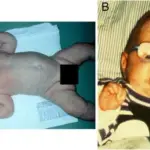Accessory axillary breast tissue is due to residual breast tissue that remains after normal embryologic development. Accessory axillary breast tissue is an uncommon condition. Accessory axillary breast tissue is located in the axilla (armpits) where it can cause diagnostic difficulty, especially if it is large.
What is the Pathology of Accessory Axillary Breast Tissue?
The pathology of accessory axillary breast tissue is:
-Etiology: The cause of accessory axillary breast tissue is a hormonal stimulation and may become more evident during menarche, pregnancy, or lactation. The hormonal changes during pregnancy and lactation may cause accessory breast tissue to increase in size and stimulate lactation.
-Pathogenesis: The sequence of events that lead to accessory axillary breast tissue is the failure of regression or displacement of the milk line. The independently migrating nests of precursor primordial breast cells can develop in a completely random manner or accessory breast tissue develops from modified apocrine sweat glands.
-Morphology: Aberrant breast tissue is usually present along the milk line, either above or below the normal breast location. It is commonly located in the axilla, but may be located outside the milk line, which includes the face, neck, trunk, and extremities.
-Histology: The histology associated with accessory axillary breast tissue shows the accessory fragments of breast tissue outside the periphery of the gland lacks organized secretory systems.
How does Accessory Axillary Breast Tissue Present?
Patients with accessory axillary breast tissue typically are female although they may be male. Accessory axillary breast tissue may present at age range. The symptoms, features, and clinical findings associated with accessory axillary breast tissue include fluctuating swelling or tenderness of breasts. The accessory nipples and areolas may darken. Decreased progesterone may cause accessory axillary breast tissue to become engorged and painful, which is the case a few days after delivering a baby. Occasionally, milk ducts within the accessory axillary breast tissue may become engorged, causing pain in the armpit.
How is Accessory Axillary Breast Tissue Diagnosed?
Accessory axillary breast tissue is diagnosed by physical exam, which may further requir imaging evaluation that may include an ultrasound or mammography. Occasionally, diagnostic breast MRI is used in challenging circumstances.
How is Accessory Axillary Breast Tissue Treated?
Accessory axillary breast tissue is treated with surgery such as liposuction or excision. Patients may enjoy an elimination of undesirable contours in the underarm area.
What is the Prognosis of Accessory Axillary Breast Tissue?
The prognosis of accessory axillary breast tissue is good.



